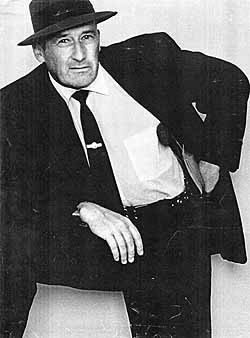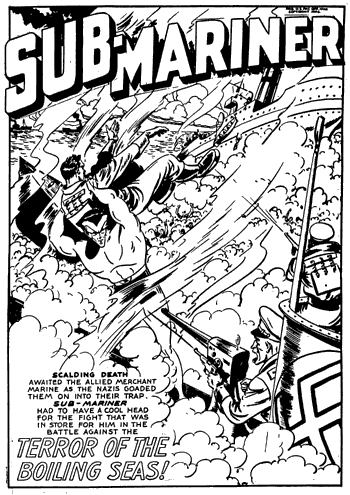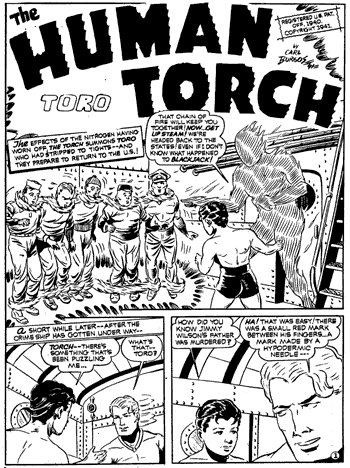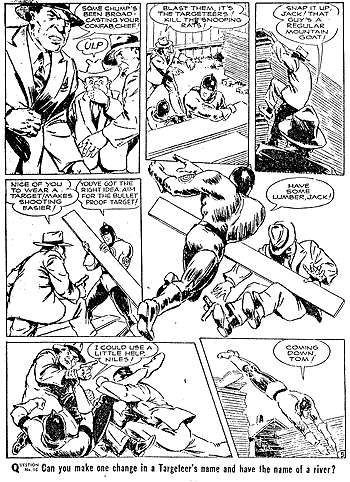TwoMorrows Publishing - Alter Ego #11 (original) (raw)
"Comics Were Great!"
A Colorful Conversation with MICKEY SPILLANE
Conducted by Roy Thomas - Transcribed by Jon B. Knutson
From Alter Ego Vol. 3 #11
[NOTE: As the creator of hard-boiled detective Mike Hammer and the author of I, the Jury and many other novels, Mickey Spillane is one of the bestselling authors of the 20th century. It's been known for decades that he wrote for comics during the 1940s, but he has rarely talked about these experiences at length. Early in 2001 fan-writer Chris Irving interviewed Spillane in conjunction with a different project for TwoMorrows, and was later instrumental in setting up the following phone conversation between Spillane and Ye Editor. For that, and for allowing us to print material which to some extent anticipates his own interview with the writer, we thank him most sincerely. —RT.]
 A photo of Mickey Spillane a couple of decades back. Courtesy of Jerry de Fuccio.
A photo of Mickey Spillane a couple of decades back. Courtesy of Jerry de Fuccio.
ROY THOMAS: When we were setting up this interview, you mentioned you'd worked for "the magazines," meaning, I take it, the pulps, before getting into comics.
MICKEY SPILLANE: Oh, yeah. That's a long time ago. I was writing mostly mystery stories, or adventure stories. Don't ask me the titles, there were so many!
RT: There were thousands, I know. I believe you used to write features for newspapers, too.
SPILLANE: I did stuff for King Features. See, you're going back here sixty years. It was around the time I did comics. I was continually writing. It was a business. I don't know the titles of the magazines I wrote for. I had a lot of the old magazines and whatnot on my shelves, and then Hugo just pretty much destroyed it all. I lost the house, I lost everything I had except my valise. [NOTE: Hurricane Hugo, one of the most devastating storms ever to hit the South Carolina coast, struck Murrells Inlet in 1989. —RT.]
RT: That's terrible.
SPILLANE: Oh, I got another house. [laughs]
RT: Was your radio work also before the war?
SPILLANE: Yeah, I did a lot of that. I was even into early television, but you didn't take note of all these things you were doing. People don't know that, back in 1936, they were broadcasting stuff from Coney Island. The first tower built for long-distance stuff was up in Newburg, New York.
RT: So when and how did you get into comic books? Was it about 1939?
SPILLANE: I don't know the year, but Ray Gill—who was a good artist and a good writer—I was a friend of his brother's. Joe later turned out to be a great comic book writer. He introduced me to Ray, and Ray said, "Come on, give comics a try." So I went up with Ray, and I started—Bam!—right into Funnies, Incorporated. I was doing other things on the outside, but then I got into comics, and I started to enjoy it. Now don't forget, I'm not a young guy! But I was then—and all these new experiences were pretty exciting and nice and enjoyable. I was never a comic book reader until I got into the business itself.
RT: Lloyd Jacquet put together Funnies, Inc. What was it like to work for him for that year or two?
SPILLANE: Oh, that was a lot of fun! Boy, he was a very strange man. He looked just like [General Douglas] MacArthur; he looked so much like him that he used to smoke a corncob pipe! [laughs] But he was a nice guy, he let us alone, we did our jobs. We were a studio. We did things for other publishers. Funnies did not publish itself.
RT: I know that two of the main companies they packaged for were the early days of Martin Goodman's Timely Comics, and Novelty, for which you did a lot of work. Novelty did Four Most, Blue Bolt, Target.
SPILLANE: Oh, yeah, I did a lot of those.
RT: When whole books were produced by Lloyd Jacquet and Funnies, Inc., did Funnies just make up the package and present it to the publisher, or did the publisher tell Jacquet what the book's name was, or what the characters might be?
SPILLANE: Lloyd Jacquet acted as an independent group. They presented the entire concepts right there. The ones who published it exercised editorial concept of a grand nature; they didn't edit. We took our pleasure in screwing them.
RT: [laughs] How's that? It's okay to tell now! It's a long time ago.
SPILLANE: I'll give you an example. Now this, I didn't do, but some others did. They had a medieval scene, and in the background, all the slaves were carrying in these big things—a boar's head, a pig with an apple in his mouth and so forth, and in the midst of all these things, there's a slave who's got a big tray, and what he's carrying is a large [male sex organ]! [laughs] And nobody noticed it! And it was put there to be noticed and edited out with a blue pencil, and they already had a covering thing they could just paste right on there, to put something else in place of it. It was just a joke. Their editors never saw it, and it got printed!
RT: Bill Everett told me how guys would put in stuff, just for fun, figuring it would be taken out. But sometimes it wasn't. Anything else you can tell me about Lloyd Jacquet? I've been interested in him ever since Bill used to talk to me about the Funnies, Inc., days.
SPILLANE: Well, Lloyd never could understand artists and writers. He was a general overseer of us. I don't think he quite knew what he was doing. But he was a nice guy. Let me give you an example of what happened. I used to make up these little helicopters; they were pieces of paper, cut, only about 2-3 inches long, but they'd spin down like... you know these things from a tree, the "polynoses," they used to call them? The seeds would spin down, they'd have the leaf in the top, like an airflow design. Well, we used to make these things up, and just have fun... it was just doodling, that's all, and throw them up, they'd spin down. The kids loved to see them. I still make them for the kids.
One day, we were having fun, we must've made 500 of these things, and we put them in a big box and were going to dump them out the window and see what would happen. Now, we were on the 19th floor or something, and it was a Saturday afternoon. It was in the summertime, and the sun was hot, and we took this box of these little helicopter things and we dumped them out the window! But instead of going down, the air current from the heat of the ground sent these spinning little things up! And they went up and up and up, and the sky was covered with these things, to the point where the people on the ground noticed them, with a "What's that?!?" [laughs]
And they drifted across the Hudson into Jersey. I think the Daily News and the Elizabeth Daily Journal reported on them. I had copies of that, but again, that went out with Hugo. They didn't know what it was! Lloyd Jacquet, he knew what it was! [laughs] He was very discombobulated with the whole thing.
RT: I've heard that, after Pearl Harbor, Funnies, Inc., and a lot of comics shops stayed in business by hiring women artists and writers, the very young, and the older artists.
SPILLANE: Oh, they were terrible. They had a bunch of creeps come in there, and we went into the military right away, and they took over all our stuff. When we came back, we were faced with the fact that these guys had taken over the jobs we used to have, so we decided we've got to get them out. They'd formed a union, that's what the problem was, and we were going to kill that union. Because these guys, they didn't have the talent that we had, I'll tell you that! So we went in, and we just lowered the price! "You're giving them all this money; we'll do it for half the price."
RT: Servicemen were supposed to get their jobs back, but I know that was easy to get around, because you had been freelancers.
SPILLANE: These were freelance jobs, so they didn't have to give them back to us. So we went in and said, "Okay, we'll be freelancers, we're gonna cut the price down." We wiped these guys out of their spots, and they bitched and yelled, but tough! We got back in the business, and then our prices went up. [laughs]
 This entire Carl Pfeufer-drawn story from Marvel Mystery #42 (April 1943) was printed in color, from these photocopies of the original art, in the 1997 trade paperback The Golden Age of Marvel. Both volumes of this excellent series—plus the 1999 special Marvel Mystery Comics #1 (since there'd never before been a comic with precisely that title and number), in addition to reprints of Human Torch #5 and All Winners #19—were edited by Tom Brevoort and are still available from Bud Plant Comic Art; phone (800) 242-6642 and tell 'em Alter Ego sent you! No real Golden Age super-hero fan can be without any of these high-quality items—or Marvel's two-volume reprinting of Captain America #1-10 by Simon & Kirby! [©2001 Marvel Characters, Inc.]
This entire Carl Pfeufer-drawn story from Marvel Mystery #42 (April 1943) was printed in color, from these photocopies of the original art, in the 1997 trade paperback The Golden Age of Marvel. Both volumes of this excellent series—plus the 1999 special Marvel Mystery Comics #1 (since there'd never before been a comic with precisely that title and number), in addition to reprints of Human Torch #5 and All Winners #19—were edited by Tom Brevoort and are still available from Bud Plant Comic Art; phone (800) 242-6642 and tell 'em Alter Ego sent you! No real Golden Age super-hero fan can be without any of these high-quality items—or Marvel's two-volume reprinting of Captain America #1-10 by Simon & Kirby! [©2001 Marvel Characters, Inc.]
RT: All the work you did for, say, Timely or Novelty—was that all done through Funnies, Inc., or were you one of the people like Carl Burgos and some others who were later hired independently by Goodman?
SPILLANE: We had a guy—I'm trying to think of his name. Anyway, he was a courier between a couple of places at that time. He would come up to me—because I always had stuff I'd hand him—and say, "Hey, we need a couple of short stories," or "We need a six-page story for something, and we need it right away!" And I'd have something already written! We knew these things would come up, see?
RT: You wrote them in your spare time, figuring there'd be a chance to sell them later?
SPILLANE: Right. We'd hand in this thing, and I'd get a check back, but it didn't go through Funnies. I was working as an independent entrepreneur.
RT: And working for Funnies at the same time.
SPILLANE: Oh, sure! The money for Funnies wasn't all that big. I was making more money on the outside doing this! Anyway, this is what happened, a lot of the time. These are the things that happened in the business that's long since been changed, you know?
RT: I'd like to ask you about a few people. Since Chris Irving has done an interview with you that'll be published later, and I don't want to step on his toes—and he talks a lot with you about Tom Gill and Joe Gill—let's talk about a couple of guys you didn't discuss with him. For example, what do you remember about Carl Burgos and Bill Everett?
SPILLANE: These guys were great! They were the leaders in the field, and you've got to remember that, when they were doing these things, printing and reproduction of the things were not as good as they are today. Some of those fellas worked with brushes, others worked with pens—I mean, a lot of different techniques! And these guys were young, and as they were working, they were improving. So the latest stuff these fellas did was much better than it was in the beginning—except that the primitive stuff was always fine to look at! I enjoy seeing that stuff. I enjoy seeing "Sergeant Spook" and "Sub-Zero" in those early days, because they were in a primitive form. Later, they evolved, and they came to be pretty fancy artwork. A lot of these guys turned out to be great artists.
Ed Robbins, for instance, became a great painter. He was a pen man, but he did great paintings. Some of these other guys... Who was the Eskimo? I can't think of his name? He and his mother used to talk in clicks and clacks.
Anyway, these guys were great, but they got out of the business into other things. Who's the guy from Oregon? I can't remember his name, I've got his books here in everything. He drew the ugliest faces in the world.
RT: Basil Wolverton? He did "Powerhouse Pepper" later.
SPILLANE: Wolverton, yeah! I remember the time when there was a contest on for the ugliest face in the world.
RT: His "Lena the Hyena" character for Al Capp in Li'l Abner, right.
SPILLANE: Every one of us knew he was gonna win; and he did. These were guys who had great artistic abilities; on top of that they were able to make these things, invent things. Fantastic! I was always amazed at the abilities of an artist. It's incredible what they can do, and as they improve, they get so much better. I hate to see people get old and decrepit.
RT: When did you go into the service? Was it early '42?
SPILLANE: I went into pilot training, and from the time I went into the service—that's where you get in, you're sworn in—until my class was called was a period of time, but I went in early. My class wasn't called up for sometime later.
RT: You were a fighter pilot.
SPILLANE: Yeah.
RT: Chris' interview deals primarily with World War II, which is the only reason I'm not following through on that, because that's a period of special interest to me.
SPILLANE: The kids need to know there was a World War II. They need to know when planes had propellers.
RT: Even if they don't know—it still happened. Someday nobody will remember the early days of the Internet, either. Everybody is history, sooner or later.
SPILLANE: That's right. [laughs]
RT: Somebody wrote once—but I think he was just guessing—that during the early days you wrote characters like Sub-Mariner, Captain America, Human Torch, and that you wrote some of the most violent of their stories. Do you think your comics stories were especially violent, compared to others'?
SPILLANE: Violent comics? Which ones were they?
 Beginning in 1939 Bill Everett and Carl Burgos set the pace with "Sub-Mariner" and "The Human Torch," respectively—as per this Burgos page from Human Torch #4 (Spring 1941). But to Mickey Spillane, Burgos and Everett were like burning ships that passed in the night. Repro'd from photocopies of the original art. [©2001 Marvel Characters, Inc.]
Beginning in 1939 Bill Everett and Carl Burgos set the pace with "Sub-Mariner" and "The Human Torch," respectively—as per this Burgos page from Human Torch #4 (Spring 1941). But to Mickey Spillane, Burgos and Everett were like burning ships that passed in the night. Repro'd from photocopies of the original art. [©2001 Marvel Characters, Inc.]
RT: They meant like "Sub-Mariner"...
SPILLANE: I wrote a lot of those.
RT: Huge armies of Germans and Japanese would just be slaughtered by Sub-Mariner and the other Timely heroes...
SPILLANE: I never wrote those war comics. I stayed away from those. I was in the service then, anyway. Oh, I would come back, every once in a while when I needed any money, I would write them stories and send them in to them.
RT: Oh, so you did a few while you were in the service, while you were still in the camp? A lot of people did that. You mentioned "Sergeant Spook" earlier. Did you, as far as you know, write the first story of that Novelty character, or did you come on after somebody else had done the first story?
SPILLANE: You know, I don't know. It's possible. There were a lot of things I wrote—they existed for a few issues, and then disappeared. I did a lot of "Sgt. Spook"; that was a favorite of mine. And "Sub-Zero"... I don't know who drew them.
RT: And "Target and the Targeteers,"
SPILLANE: I did a lot. Is Sid Greene still alive? He was the artist of "Target."
RT: I think he passed away a few years ago. He drew for DC in later years.
SPILLANE: Sid was younger than me!
RT: Do you remember anything else about Burgos or Everett?
SPILLANE: No. I was never that close. I was in a different group, so I really didn't know about their lifestyles; I just knew them in a business sense. We just sort of hung around and... by Funnies, we were all together up there. These other guys, Everett and them, would come in and out, you know?
RT: I'll just mention the names of a few people at Timely, and you can tell me if you recall them. If you don't, that's fine, too. I believe you knew Harry Sahle? He started out as Burgos' assistant, and became a full artist later, especially important on "Archie."
SPILLANE: Oh, Sahle, sure! He drew the great caricature of Mike Hammer which was "Mike Danger" in the very beginning. Mike Hammer started as a comic book character. But then the war came along! Tekno-Comics published Mike Danger a few years back. We had a very successful two-year run. In the very first issue, there's a big story there, there's a page... and that picture of Mike Danger was the original concept of Mike Hammer.
RT: I was once interviewed by Tekno-Comics down in Florida for the job of editor-in-chief. I wouldn't really have taken it, because I wasn't interested in moving; I was just curious to see what their set-up was like, so when they sent me a plane ticket, I figured what the hell. I met you at a San Diego Comicon when you were doing the convention circuit to publicize the Tekno-Comics Mike Danger.
Do you remember Joe Simon & Jack Kirby? They went up to Timely, while you were still at Funnies.
SPILLANE: I might've written for them, I'm not sure. We did so much for so many. In those days, nobody was paying us! [laughs]
RT: Of course, Simon & Kirby were better known than most in the field, but only to comics readers. Did you know Syd Shores, who became the main Captain America artist?
SPILLANE: I don't remember having ever met him.
RT: Some of these people probably started up about the time you were leaving the field, and you didn't have much opportunity to meet them. Another couple of people who worked on Captain America were Al Avison, Vince Alascia, and Al Gabrielle.
SPILLANE: I remember them, but I don't remember any communication between us. We kind of worked at distances. For instance, we'd do the stories, the stuff would come back to us inked or sometimes just the pencils, and we'd check everything out, and that was it! You never knew the guy on the other side. You'd know all about them, you talked to them over the phone and whatnot, or they'd call you for corrections and so forth. But you'd never have any personal relationship.
RT: Another early artist who did work for Novelty was George Mandel. He was a childhood friend of another writer—Joseph Heller, the author of Catch-22. He's mentioned in Heller's memoir Now and Then, which came out a few years ago.
SPILLANE: Gee, we haven't seen each other since the war. What did he do in comics?
RT: Mandel drew some Timely strips: "The Angel," "The Patriot," "Black Marvel." Heller says he was wounded in the war—came back, got well, then went back over and got a bad head wound that continued to bother him forever after. Heller said he should've stayed out the first time! Heller talks in his book about envying Mandel when he was making a lot of money early on in the comics and was driving around in a fancy new car, while everybody else in Brooklyn was walking.
SPILLANE: Or taking the subway.
 Among the features at Novelty Press which Spillane sometimes wrote was "Target and the Targeteers" (art here by Ken Battlesby?) in 1941 issues of Target Comics. But did he write this story? You tell us! Art courtesy of Jerry Bails.
©2001 the respective copyright holder.
Among the features at Novelty Press which Spillane sometimes wrote was "Target and the Targeteers" (art here by Ken Battlesby?) in 1941 issues of Target Comics. But did he write this story? You tell us! Art courtesy of Jerry Bails.
©2001 the respective copyright holder.
RT: Did Novelty have its own artists, or did everything come from Funnies?
SPILLANE: You're talking about so many things that were happening—we couldn't put a tag on them, and now you're coming back on me 60 years later—well, I'm 83!
RT: I'm not trying to put you on the spot; I'm just interested in the history of it all.
SPILLANE: I know. I'm just trying to figure it out! Nobody ever asked me these questions.
(For the rest of the Mickey Spillane interview, be sure to pick up ALTER EGO #11!)
 Sign up here to receive periodic updates about what's going on in the world of TwoMorrows Publishing.
Sign up here to receive periodic updates about what's going on in the world of TwoMorrows Publishing.
Click here to download our new Fall-Winter catalog (2mb PDF file)
Howard Keltner's Golden Age Comic Books Index is the premier references for Golden Age comics! Bob Klein worked with Howard to make this edition available, just before Howard's untimely death in 1998. Howard's widow has graciously given us permission to give the index away for free for all to enjoy! Click here to view! (1.5 MB file. Adobe Reader required.)
All characters are © their respective companies. All material © their creators unless otherwise noted. All editorial matter © Roy Thomas. Alter Ego is a ™ of Roy & Dann Thomas. FCA is a ™ of P.C. Hamerlinck.
Website © 1995-2003 TwoMorrows Publishing.
